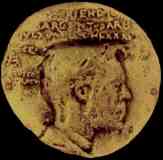(Frontpage) (What's New Page) (Refer This Site )
| (page 4 of 5) |
| The Sargent I Knew by Mary Newbold
Patterson Hale
(Frontpage) (What's New Page) (Refer This Site ) |
|


John D. Rockefeller Sr 1917 |
There are few portraits of John Sargent; he disliked being drawn or painted or modelled. A long serious of photographs begins with a little boy of perhaps seven, and closes a year before his death. St. Gardens made a portrait medallion of him in 1889-90, he painted his own portrait twice -- once for Uffizi and again for the national Academy of Design. The most characteristic likeness is in Herkomer's group of Royal Academicians [1], hanging in the Tate gallery. Mr. Raymond Crosby's delightful portrait drawing is Sargent himself [n/a], his head bent over book, music, or chess board. It shows the profile well remembered by all who played duets with him, and I especially prize it as my first recollection of him is playing duets when I was a very small child. In 1916 Sargent came to America after an absence of thirteen years, to install the last portion of his decorations in the Boston Public Library. He was lame, for a big packing case had fallen on him in his studio as he was seeing the decorations off. A small bone in one foot had been broken and he had been in bed for a fortnight, delaying his journey. He pitched into his work here at once, despite his temporary ailment, gathering up the threads of old friendships and made new ones, finishing his Library work and accepted a commission to decorate the dome of the Boston Museum of Fine Arts, painted two portraits of Mr. Rockefeller and a portrait of President Wilson [n/a]. He traveled to the Canadian Rockies in the summer and Florida in the winter [1917], and Fenway Court, the Fogg Museum, and the Worcester Museum are the richer because of those journeys. "Rockerfellering" at Ormond was mitigated by the sea bathing, for Sargent was a strong swimming and delighted in the exercise. Miami held him because of the beauties of Viscaya. "It is very hard to leave this place," he wrote me. "There is so much to paint, not here but at my host's brother's villa. It combines Venice and Frascati and Aranjuez, and all that one is likely never to see again. Hence this linger-longering." In the spring of 1917 he returned to England at the worst phase of the submarine attacks. He had planned the changes in the dome of the Boston Art Museum to be finished in London. Sargent detested the packing which
these moves entailed and was bothered by the disposition of the hoards
of possessions of one sort or another, which gathered about him as by atomic
attraction. He lived at Copley Plaza Boston, and opposite on the Trinity
Place side of the hotel was a large open space where the school of Technology
had stood, scattered over with heaps of brick and rubbish of the demolished
buildings. This, Sargent was inspired to think, was the best place to deposit
packages of old clothes or what not, so he tied up newspaper parcels and
placed them amidst the rubbish, one or two at a time, under cover of night,
looking out of the tail of his eye the next morning as he passed by to
his studio to see if the packages were gone. The first deposit lingered
a day or two, and he was beginning to despair, but on the third day it
was gone! Thus encouraged he made daily contributions to the comfort of
the great unknown and unwashed until all the things he did not want had
passed from his possession.
A Biddable Child | A Musical Genius Spoiled | Painted Diaries | Portrait of Sargent | At the Front in France Note:
|


Saint-Gaudens's medallion of John Singer Sargent Bronze, 6.4 cm (2 1/2 in.) diameter Musée d'Orsay, Paris, France |

Help Me Identify Broken Links